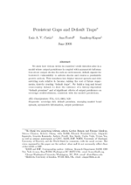Persistent Gaps and Default Traps
Date
Jun 2008
The authors of this paper show how vicious circles in countries' credit histories arise in a model where output persistence is coupled with asymmetric information about output shocks. In such an environment, default signals the borrower's vulnerability to adverse shocks and creates a pessimistic growth outlook. This translates into higher interest spreads and debt servicing costs relative to income, raising the cost of future repayments, thereby creating "default traps". We build a long and broad cross-country dataset to show the existence of a history-dependent "default premium" and of significant effects of output persistence on sovereign creditworthiness, consistent with the model's predictions.



